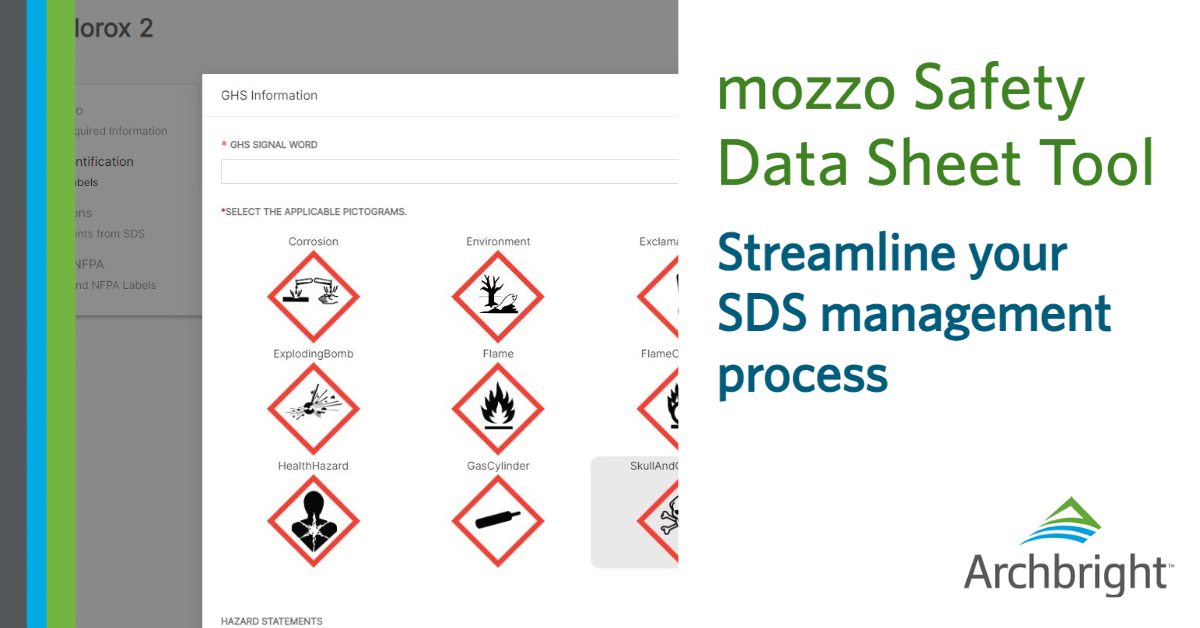Early Info on Top Ten Safety Violations
The Occupational Safety and Health Administration (OSHA) officially announces its top ten most frequently cited standards every April for the...
5 min read
 Tiffany Knudsen, SMS
:
Jun 7, 2023 10:29:44 AM
Tiffany Knudsen, SMS
:
Jun 7, 2023 10:29:44 AM

Is your organization one of the millions of workplaces in the U.S. that uses chemicals? Chemicals are found in numerous industries and used in a wide variety of tasks, from cleaning products to farming to manufacturing processes. Although helpful, if not correctly addressed, chemicals can present an array of health hazards, such as irritation, sensitization, and carcinogenicity, in addition to physical dangers, such as flammability, corrosion, and explosibility. Employers are responsible for providing a safe work environment and training employees to take proper precautions when working with chemicals. Safety Data Sheets are crucial in providing comprehensive information about the potential hazards, safe handling procedures, and emergency measures associated with these substances.
Safety Data Sheets (SDSs), formerly known as Material Safety Data Sheets (MSDSs), are standardized documents created by a chemical manufacturer that provides detailed information about potentially hazardous chemical substances. Every chemical has a corresponding SDS, organized into 16 predetermined sections, each addressing specific aspects of the substance. SDSs are not intended for general consumers. Instead, they provide detailed safety information about working with the chemical substance in an occupational setting.
Many employers are familiar with the previous MSDS system. The MSDS and SDS system is essentially the same, with the purpose remaining unchanged. However, the Occupational Safety and Health Administration (OSHA) adopted the United Nation’s Globally Harmonized System (GHS) as a method to standardize chemical data sheets and chemical container labels, regardless of the company of origin. The previous MSDS system was not standardized, allowing countries to utilize the chemical data sheets differently. The updated SDS system follows the GHS standards, specifying what information is required on the data sheets and how it must be organized. Employers still utilizing MSDS systems must update their data sheets to the SDS format.
SDSs are designed to help workers, emergency responders, and others who encounter chemical substances understand the associated risks and the safety precautions that must be taken. SDSs serve as valuable resources for workplace safety by:
Employers with hazardous chemicals in the workplace are required to follow the OSHA’s Hazard Communication standard, 29 CFR 1910.1200, which specifies that employers must provide information and training to their workers about the hazardous chemicals to which they may be exposed. This information must be communicated via a comprehensive Hazardous Communication program. As part of this program, SDSs must be made readily accessible to workers.
In addition to making SDS readily accessible, employers must:
It’s important to note that employers in states with state-run safety agencies, such as those found in Washington, Oregon, and California, must adopt measures that meet or exceed these federal requirements. Employers are encouraged to check their state for additional rules.
As you can imagine, finding a system to stay organized is vital to keeping SDSs current and available in the event of an emergency. Employers are encouraged to think about the best way to accomplish this organization. Many workplaces keep an active collection of SDSs and the consequent inventory list in a binder. Some employers utilize an electronic system that archives chemicals no longer used to keep the current SDS library manageable.
Although adding SDSs to a binder that workers can access is a simple solution, binders can become mismanaged and even damaged when left on a shop floor. If not kept current or formatted in a way to make finding a needed SDS easy, the purpose of the management system is lost. Online systems can solve these issues, but all workers need access to the information, and many systems can be complicated to set up. Additionally, workers still need access to SDSs even if the power goes out.
Archbright encourages employers to find a happy medium to address these issues. Having an SDS Administrator, typically the person(s) responsible for purchasing chemicals, set up an online system can keep the SDS library current and organized. Providing employees with a shared kiosk and read-only access to this information makes it available and easy to retrieve. Going a step further and laminating copies of the chemicals that workers use most often and then making them available in workstations solves for emergency situations.
In addition to the Hazard Communication requirements listed above, as part of GHS, chemical containers must be labeled with specific GHS labels. The information on original-shipped chemical containers must include a signal word, pictograms which are images that communicate the substance’s hazards, a hazard statement, and a precautionary statement for each hazard class and category. All this information can be found on the chemical’s SDS. Employers who utilize secondary containers for chemicals, such as dispensing a small amount of a chemical from a drum into a smaller container for use, must utilize secondary container labels, which can be in the form of a simplified GHS label, a National Fire Protection Association (NFPA) label, or a U.S. Hazardous Materials Identification System (HMIS) label.
Safety Data Sheets are essential tools that contribute to workplace safety by providing crucial information on hazardous substances. Making the information available to workers, emergency responders, and others who encounter these substances in the workplace allows them to understand the risks and take precautions to protect themselves, others, and the environment. Employers must have a well-designed system that makes this information available without delay.
For this reason, Archbright has created a new mozzo Safety Data Sheet feature. This feature makes managing an SDS library and printing secondary container labels a snap. Employers with mozzo access can quickly create an electronic SDS library that allows workers to view, download, and print SDSs when needed. The feature automatically builds and updates the chemical inventory list as SDSs are added or modified. When chemicals are no longer used, employers can add the corresponding SDS to an archive library, keeping the chemical inventory list current and the archived information stored for the mandatory retention period. If chemicals go back into service, the function can be reversed. Workers also can print secondary container labels in the GHS, NFPA, and HMIS formats on demand. The mozzo Safety Data Sheet feature has been designed with simplicity and convenience in mind, making it an easy choice for SDS management.
In addition to the mozzo Safety Data Sheet feature, employers can view and assign Hazard Communication and Safety Data Sheet Microlearnings in the mozzo Video Library and find several related templates, including a sample Hazard Communication Program, in the mozzo Resource Library. Employers interested in learning more about mozzo and its many features are encouraged to contact info@archbright.com.

The Occupational Safety and Health Administration (OSHA) officially announces its top ten most frequently cited standards every April for the...

The beginning of the year is a classic catalyst to “start fresh,” an opportunity to take stock and improve anything that was not optimal in the prior...
Every employer wants to attract and retain the best workers. There are several ways to accomplish this, such as writing effective job descriptions,...